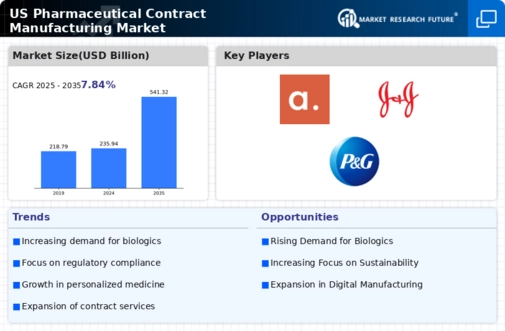Rising R&D Expenditure
The pharmaceutical contract-manufacturing market is experiencing a notable increase in research and development (R&D) expenditure. Pharmaceutical companies are allocating larger budgets to R&D, driven by the need for innovative therapies and advanced drug formulations. In the US, R&D spending in the pharmaceutical sector reached approximately $83 billion in 2024, reflecting a growth of around 7% from the previous year. This trend indicates a robust pipeline of new drugs, which in turn fuels demand for contract manufacturing services. As companies seek to expedite the development process, they are increasingly relying on contract manufacturers to provide specialized expertise and resources. This shift not only enhances efficiency but also allows pharmaceutical firms to focus on core competencies while leveraging the capabilities of contract manufacturers. Consequently, the rising R&D expenditure is a significant driver of growth in the pharmaceutical contract-manufacturing market.
Regulatory Landscape Evolution
The evolving regulatory landscape is significantly impacting the pharmaceutical contract-manufacturing market. Regulatory agencies in the US are continuously updating guidelines to ensure drug safety and efficacy, which in turn affects manufacturing practices. The introduction of more stringent regulations has led pharmaceutical companies to seek contract manufacturers with robust compliance capabilities. In 2025, it is estimated that compliance-related costs for pharmaceutical firms could account for up to 10% of their total manufacturing expenses. This trend highlights the necessity for contract manufacturers to invest in quality assurance and regulatory expertise. As companies navigate the complexities of compliance, the demand for specialized contract manufacturing services is likely to increase. Therefore, the evolving regulatory landscape serves as a critical driver for growth within the pharmaceutical contract-manufacturing market.
Increased Demand for Specialty Drugs
The pharmaceutical contract-manufacturing market is experiencing heightened demand for specialty drugs, which are often more complex to manufacture than traditional pharmaceuticals. Specialty drugs, including biologics and gene therapies, require advanced manufacturing techniques and stringent quality controls. In the US, the market for specialty drugs is projected to grow at a CAGR of 9% through 2026, driven by rising incidences of chronic diseases and advancements in personalized medicine. This surge in demand is prompting pharmaceutical companies to partner with contract manufacturers that possess the necessary expertise and capabilities to produce these complex products. As the landscape of drug development continues to evolve, the increased demand for specialty drugs is likely to remain a significant driver in the pharmaceutical contract-manufacturing market.
Growing Focus on Supply Chain Resilience
The pharmaceutical contract-manufacturing market is witnessing a growing emphasis on supply chain resilience. Recent disruptions in global supply chains have prompted pharmaceutical companies to reassess their manufacturing strategies. In the US, firms are increasingly prioritizing local sourcing and production to mitigate risks associated with international supply chains. This shift is reflected in a reported 15% increase in contracts awarded to domestic manufacturers in 2025. By fostering closer relationships with contract manufacturers, pharmaceutical companies aim to enhance their agility and responsiveness to market demands. Additionally, the focus on supply chain resilience is driving investments in technologies that improve visibility and traceability throughout the manufacturing process. As a result, the growing focus on supply chain resilience is emerging as a key driver in the pharmaceutical contract-manufacturing market, influencing how companies approach their manufacturing partnerships.
Technological Advancements in Manufacturing
Technological advancements are playing a crucial role in shaping the pharmaceutical contract-manufacturing market. Innovations such as automation, artificial intelligence, and advanced analytics are enhancing production efficiency and quality control. For instance, the adoption of continuous manufacturing processes is gaining traction, allowing for more streamlined operations and reduced production times. In the US, the implementation of these technologies has been linked to a potential reduction in manufacturing costs by up to 20%. Furthermore, the integration of data analytics enables manufacturers to optimize supply chain management and improve decision-making processes. As pharmaceutical companies increasingly seek to enhance their operational capabilities, the demand for technologically advanced contract manufacturing services is likely to rise. This trend underscores the importance of staying at the forefront of technological developments within the pharmaceutical contract-manufacturing market.














Leave a Comment